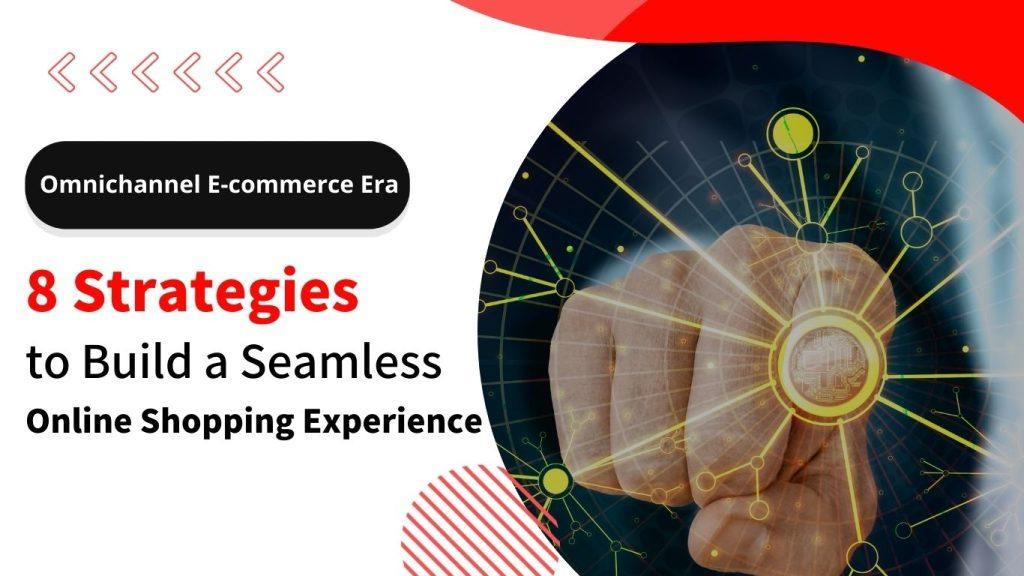Running e-commerce is challenging because owners must strike a balance between several factors affecting their business growth, and explore a number of techniques that will best suit their demands. Knowing what omnichannel is and using it in your e-commerce business could be a terrific idea if you’re looking to grow your online store.
Unlike multi-channel retail, omnichannel retail places a premium on the consumer experience, with a seamless experience strengthening the brand’s image. To prepare you for the post-e-commerce age, this article will break down the fundamental principles and must-knows of omnichannel development.
Learn how to increase client retention to 89% and obtain more loyal consumers right NOW!
What is Omnichannel E-commerce?
Customer data, shopping behavior, and other relevant information, including customer service, are combined in omnichannel e-commerce, defined as the “integration of multiple channels”. The term “omnichannel” refers to a strategy where businesses utilize consistent messages, graphics, and collateral to advertise their products and services across all available platforms. This ensures that customers receive a positive purchasing experience regardless of how they consume or engage with the brand.
In Omnichannel e-commerce, customers will be able to feel involved and have their experiences personalized. Merchants may reach out to the right leads at the right time and convert them later into customers by taking advantage of the strengths of each communication channel.
The following examples can help you better comprehend the concept of omnichannel:
- If a customer has already purchased a product, no additional promotions or remarketing will be sent to them (SMS promotions, email reminders, etc.)
- After abandoning items in their online shopping cart, customers receive Facebook remarketing ads.
- Email reminders of unused physical and electronic coupons are sent to consumers
The operation of Omnichannel is based on data that is automatically updated at the bottom and is transmitted out of each channel’s system. After that, the customer will receive a customized message. Businesses rely on this automatically updated data to connect the shopping experience across all channels.
How is it different from Multichannel Retail?
Many people confuse multi-channel and omnichannel, yet their cores are not the same. Let us examine the differences between the two.
Multi-channel E-commerce |
Omnichannel E-commerce |
|
| Marketing Strategy Focus | Brand | Customer |
| Communication Mode | Primarily only one-way communication Messages from all channels are largely the same |
Messages change based on channel and consumer shopping behavior and interaction |
| Channel Update | Platforms and channels will not be updated automatically Cannot provide customized information to meet consumer needs |
Trigger different channel updates based on consumer behavior |
| Channel | Each channel operates independently | All channels can converge and work together |
| Planning Core | Taking the brand as the starting point, extending to other channels | Provide an interactive and seamless experience, with the customer in mind |
Personalizing the experience, offering material that resonates more naturally, and making it easier for customers to engage with brands are all part of omnichannel. Customers will buy more as a result of this, and the number of repeat customers will grow.
The Importance of Omnichannel E-commerce
According to Harvard Business Review, only 7% of consumers shop exclusively online, 20% in brick-and-mortar stores, and the majority across a variety of outlets. As a result, the brand concentrates solely on one channel and is unable to generate significant revenue. Instead, in order to considerably improve profits and sales, it is required to broaden the business scope for numerous channels and reach more potential customers.
Compared to a single promotion channel, omnichannel promotion can enhance brand interaction by 18.96%, whilst interaction through a one-way channel can only generate only 5.4% interaction rate. Omnichannel retail has a sales volume that is 87% larger than single-channel retail, and a consumption rate that is also 13 percent greater!
Customer loyalty can be considerably increased through omnichannel retailing in addition to sales. According to research, brands with strong omnichannel strategies have customer retention of 89%, whereas brands with bad omnichannel strategies have a customer retention rate of only 33%. Furthermore, marketers who use multi-channel retention are 90 percent more likely to keep loyal clients than those who only use one channel.
How to Implement Omnichannel E-commerce
1. Get Your Team to AGREE
Most businesses benefit greatly from omnichannel, and its feasibility is growing all the time. To implement omnichannel, you must first persuade your entire team to agree on a customer-centric retail strategy. Other departments, in addition to marketing, require a consensus in order for everyone to work together to improve customer service and implement omnichannel e-commerce.
Further reading: Digital Transformation Improves Customer Experience – the Key to Having a Successful Business During the Pandemic
2. Analyze Customer Data
The foundation of omnichannel retail customer service is consumer data. In addition, every team member should make effective use of data in order to provide a better client experience. When every employee of the organization has a thorough understanding of the customers, responding to inquiries becomes a breeze!
When analyzing customer data, you can start from these angles:
- View your brand’s customer satisfaction from different angles: Complete the whole shopping process on a website or social media platform, including connecting with the brand’s various channels and requesting customer assistance. You can also invite outsiders to assess your customer service in order to get more objective feedback.
- Collect customer feedback: Collect client satisfaction at various phases of the customer journey to learn about their preferences. Providing questionnaires and encouraging responses, for example.
Further reading: Integrate live broadcast with social media to discover eCommerce’s most powerful revenue strategy!
Various departments within the company can design different plans depending on customer data. Marketers, for example, may send customers messages that are most relevant to them, product teams can supply items that customers are most likely to be interested in, and customer service representatives can have highly engaged dialogues with customers.
3. Personalized/Customized Messages
E-commerce can categorize customers based on a range of factors such as income, location, age, online shopping patterns, value, and interaction channels. By segmenting clients into smaller groups, you may customize experiences for different customer groups, and identify client groups and marketing techniques that best suit your business.
Generally, businesses can be classified into these three categories:
- Personal Information: Demographics, Age, Gender, Civil Status, Region
- How Ads Interact: How Customers Interact with Ads and Channels
- Shopping Patterns: The client’s stage in the customer journey, shopping patterns, and consumption channel
After you’ve sorted your customers, you can send each one customized or personalized messages, which makes it easier to attract inquiries or even orders!
4. Commercial Operations
Omnichannel operations require smooth product, ordering, inventory management, and logistics processes. In addition, businesses must leverage technology to aid their operations. Inventory transparency is by far the most significant obstacle to omnichannel management, as many front-end employees are unable to accurately oversee inventory status and changes. Therefore, when businesses grow into new channels, they need to have a centralized inventory system to maintain a particular level of transparency. This will enable employees to precisely understand inventory status and synchronize data with other channels.
5. Logistics and Shipping
To handle the logistics and delivery of goods, retailers can employ cloud logistics management systems or third-party logistics platforms. The cloud logistics management system may give information such as negotiated rates and the current shipping status of many logistics companies, making it easier for you to select one! Furthermore, certain third-party logistics management platforms can offer one-stop inventory management, warehousing, replenishment, and other services, making logistics administration easier for business owners.
6. Integrate Information through Technology
Integrating existing information and technology to unify all data is one of the most critical elements of Omnichannel. Knowing the real-time status of your inventory is necessary when you start selling through multiple channels. If you want to know about related items and product comparisons, for example, a platform that incorporates all of the information can speed up your work process. Conversely, customer service professionals will struggle to obtain information and respond to customer questions if product information is scattered across multiple platforms and channels.
7. 24-hour Customer Service
Although it is not viable for many businesses to build physical stores 24 hours a day, providing 24-hour shopping via e-commerce is not difficult! When deploying omnichannel, brands must remember to include countermeasures that allow for 24-hour online service. While shopping on various platforms and devices has its own set of drawbacks, it can also lead to an increase in client inquiries.
By establishing comprehensive face-to-face, email, and online customer service, businesses may boost client loyalty and offer a personalized experience. If your online shop is unable to provide online human customer support 24 hours a day, you can utilize VIMOS’ AI Chatbot to handle frequent issues and non-business hours. This approach allows customers to obtain immediate responses even during non-business hours, minimizing customer turnover and sales team strain!
Further reading: Live Videos is the Latest Trend – Type of Retail Industries that Should Adapt Live Broadcast E-commerce
8. Test, Evaluate, and Retest
To achieve the best results, the effectiveness of advertising must pass several tests, regardless of the promotion channel brands use. You may acquire insight into your customer base and traffic sources, as well as determine which advertisements are most effective, using a data analysis tool. AB testing can also be used to see how specific elements of an ad perform. On platforms like Facebook, AB testing can be used to see how different textual content, photos, titles, and other components affect the results. Brands can learn which parts can be modified to obtain better outcomes through AB testing, thereby enhancing the quality of their marketing.
Success Stories of Omnichannel E-commerce
Sephora
Sephora’s Beauty Insider Rewards membership program has allowed the company to gain a large number of loyal customers. Through the Sephora APP’s Beauty Bag, members may access their favorite products, online or offline purchase history, and accrued points to exchange for discounts. Over 11 million Sephora members have joined the program, spending 15 times more than non-members. This shows how a strong membership program and added experience can significantly boost the value of a single order.
The virtual stylist launched by Sephora Beauty Hub, on the other hand, allows customers to sample various items on their iPads or other mobile devices, allowing them to choose their preferred products from a variety of styles and receive personalized information to purchase them directly.
Sephora’s alternative personalized experience allows users to connect items via various channels and platforms, enhancing the brand’s memorable qualities and increasing the number of loyal customers!

Clarins
Skincare brand Clarins partnered with a third-party live-streaming e-commerce platform to launch shop-ready livestreams in 10 regions this year. Customers have been able to connect with the brand via live broadcast, and professionals or special guests have been invited to explain skincare and beauty topics. This promotion raised conversion rates by over 30%, and each client spent an average of 17 minutes longer with the brand! Clarins also offers one-on-one video consultations, which allow customers to talk with sales representatives in real-time, lowering the barriers to online purchases.
Furthermore, Clarins also holds similar live events on Facebook to increase product exposure.
Aside from providing WhatsApp Messaging Automation & Chatbot, VIMOS Live E-commerce Platform also provides a one-to-one video inquiry function with salespersons, allowing customers to inquire and understand your products more clearly – making the customer service experience more comprehensive!
Online shops can promote and reach customers through different channels, such as email, SMS, web push notifications, social media, and so on, to adopt omnichannel e-commerce. Utilize automated marketing systems and data insight reports to simplify customer relationship management, improve marketing effectiveness, and boost revenue!
Sign up now to try the VIMOS Live E-commerce Marketing Platform to provide a unique experience for your customers, and quadruple your revenue!









